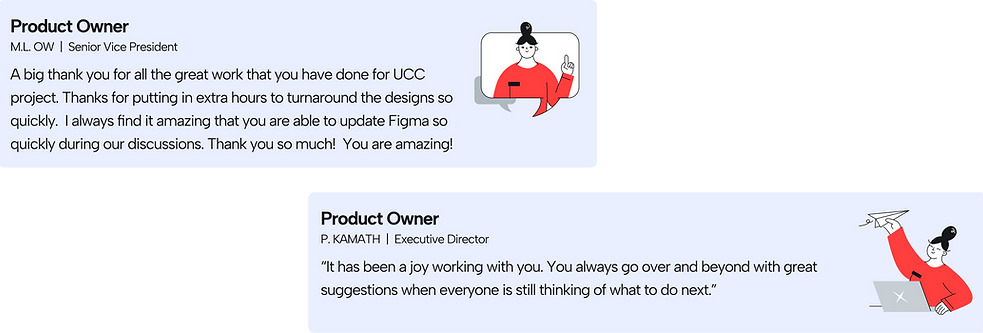Team Goal
Immediate Risk Control at Speed.
In response to the Monetary Authority of Singapore’s Notice 637 taking effect on 1 July 2024, DBS Bank implemented a risk assessment workflow for Unconditionally Cancellable Commitment Hold
(UCC Hold), enabling immediate control and drawdown blocking for corporate borrowers potentially impacted by adverse news.
My Role
From Ambiguity to Clarity.
Led UX strategy by aligning cross-functional teams to translate ambiguous business needs into scalable design solutions that enhance usability and support risk-informed decision making.
The Challenge
Parallel Builds, Timely Launch.
To ensure compliance with MAS Notice 637, the UCC Hold workflow team was challenged to rapidly develop and deliver multiple MVPs in parallel under a constrained timeline.
Result and Impact
Since the official launch on 25 Oct 2025 till Q3 2025, 300+ borrowers have been tagged or uplifted with UCC Hold tagging, which results in better capital deployment and Risk-Weighted Assets savings of more than a billion.
1. Features Walkthrough
1.1. Notifications

1.3. Case Initiation

1.2. Task List

1.4. UCC Hold Assessment Form

2. Background
WHAT is UCC Hold?
-
"Unconditionally Cancellable Commitment Hold" (UCC Hold) is a safety measure protecting DBS Bank from potential losses.
-
It helps DBS take early action by stopping giving more money to corporate borrowers if there are bad news (adverse news) indicating the corporate borrowers have trouble paying the money back.
🚨 Types of Adverse News
-
Criminal investigations into the borrower’s senior management.
-
Other banks rejecting drawdowns or demanding repayment.
-
Natural disasters or riots affecting the ongoing operations.
-
...more
HOW does UCC Hold work?
-
"Unconditionally Cancellable Commitment Hold" (UCC Hold) is a safety measure protecting DBS Bank from potential losses.
-
It helps DBS take early action by stopping giving more money to corporate borrowers if there are bad news (adverse news) indicating the corporate borrowers have trouble paying the money back.

WHY is UCC Hold Important?
The implementation of UCC Hold in the corporate credit process ensures DBS complies with MAS Notice 637, effective on 1 July 2024, reflecting Basel III capital rule reforms. (MAS: Monetary Authority of Singapore)
WHAT is the Result?
With the development of UCC Hold workflow, 200+ Relationship Managers and 80+ Credit Risk Managers will be empowered to ensure a holistic and flexible credit assessment of the corporate borrowers and their parent DOA Group that will be potentially affected by the adverse news.
HOW is UCC Hold Developed and Integrated?
Initiated in 2024 by RMG-IBG Credit in collaboration with RMG-CCO and IBG-COO Offices, UCC Hold functions with maker-checker flows, with the core built in GLOW and the user interface integrated into IBG Digital Workbench and One Risk Workbench using a unified One Design System.

3. Deliverables
Unlock More About UCC Hold
-
🎯 Targeted Or Broad
UCC Hold assessment workflow lets RMs and CRMs act precisely on borrower(s) or broadly on their parent DOA group.

-
🔒 Partial Lockdown Possibility
Borrowers within a DOA group can be mixed — some under UCC Hold, others operating normally.
To allow RMs and CRMs to take immediate and precise action on borrowers, UCC Hold workflow allows them to activate and deactivate UCC Holds for multiple borrowers in one go.

-
📝 Assessment With Rationale
RMs and CRMs need to justify the need for placing or uplifting UCC Hold on borrowers by answering questions to guide assessment, providing recommendation and the trigger event. -
↔️ Extend Beyond Initial Scope
CRMs can directly add missing borrowers and override RMs’ recommendations without sending the task back for rework, ensuring a smoother and faster workflow.


-
📝 Maker-checker Approval Chain
CRMs’ approval is required when RMs trigger UCC Hold, but CRMs can initiate it directly for urgent cases.

4. Our Approach
4.1. WHAT were the challenges for the core working group?
Design at the Helm
As UX lead, I initiated in-person and online workshops to align product vision, business needs, and technical feasibility, enabling the UCC Hold team to deliver multiple MVPs in parallel under tight deadlines.

4.2. Cross-functional Collaboration
Step 1. Tap into on-the-ground perspectives from a diverse user base.

Step 2. Target and collaborate with key stakeholders for Requirement Sign-Off.
By collaborating directly with key stakeholders of different functions, design got business buy-in after several alignment meetings.

Step 3. Reconcile UI Discrepancy across IDW and ORWB.
I partnered closely with IDW and ORWB system owners and designers to deliver a seamless user experience across platforms, despite each platform currently utilizing a different design system.

4.2. Designing Alignment Across Departments
Step 1. Communicate across departments for the onboarding to One Risk Workbench.
I bridged the gap of cross-department communication as the core of UCC Hold Assessment was built in GLOW and the user interface were integrated into IDW and ORWB.

Step 2. Fighting for more real estate for UCC Hold to be scalable in future.
Through cross-department communication, we secured alignment with the product owner of ORWB to position UCC Hold as a scalable Risk Application, ensuring a sufficient space on One Risk Workbench for future growth.

5. The Result
Since the official launch on 25 Oct 2025 till Q3 2025, 300+ borrowers have been tagged or uplifted with UCC Hold tagging, which results in better capital deployment and Risk-Weighted Assets savings of more than a billion.
Verbatim from Key Stakeholders

